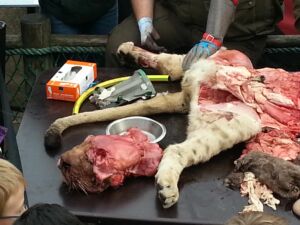Earlier today Odense Zoo dissected a nine-month-old lion cub in front of a live audience mainly consisting of parents and very excited children.
The lion, which was euthanised nine months ago due to what the zoo claimed was overcrowding, was defrosted beforehand.
Staged for educational purposes, the dissection was timed to take part during the children’s autumn half-term holiday and not the first of its kind at the zoo.
It was keenly anticipated and attended by the world’s media, which has been drumming up interest in the event since last week.
Tailored to kids
The event saw scores of people attending, some with infants as young as a couple of months. Seating was limited, with many parents having to hoist their children onto their shoulders to give them a good view.
One child loudly complained: “I can’t see anything; let’s just wait for the television broadcast tomorrow!”
Carried out in a small amphitheatre, the lion carcass was dissected by two experts, who then proceeded to educate the audience about the parts being dissected.
The demonstration was clearly tailored to the young audience, who were encouraged to answer questions about the various body parts on display.
“What do you use your nose for?” the expert asked at one point, to which the children yelled back: “To smell!” And there was more of the same.

Though outlets like the Huffington Post mentioned ‘horrified’ children, to their credit, most seemed to handle the (arguably gory) sight of the bloody organs laid out on a table incredibly well, with only the occasional startled gasp.
Many held their noses to ward off the overwhelming stench and were instructed to breathe through their mouths.
This is not the first time a Danish zoo has come under fire for putting down a healthy animal or two. The death of Marius the giraffe at Copenhagen Zoo earlier last year caused a storm, but zoo officials went on record to rally against “the disneyfication of zoos”.
And their Odense peers seem to have retained this conviction. And although the event today was as far from Disney as you can get, the children didn’t seem to mind all that much.
In fact, “Fedt!” (meaning awesome) was a cry heard from many of those present.














